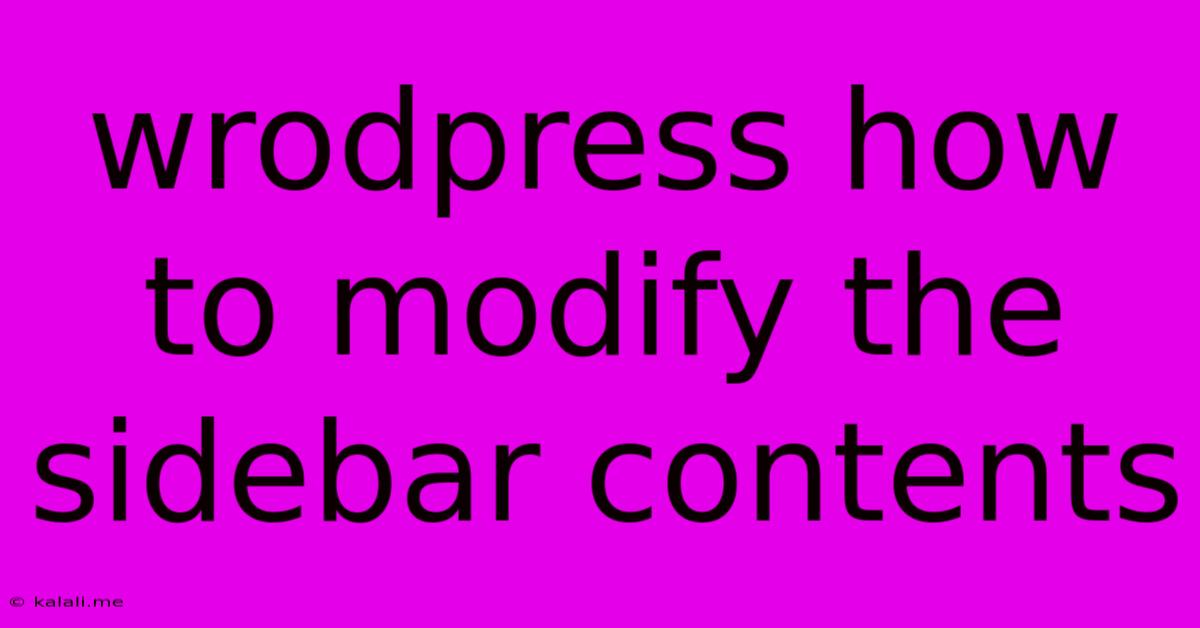Wrodpress How To Modify The Sidebar Contents
Kalali
Jun 04, 2025 · 4 min read

Table of Contents
WordPress: How to Modify Sidebar Contents – A Comprehensive Guide
Meta Description: Learn how to easily customize your WordPress sidebar, adding, removing, and rearranging widgets to perfectly match your website's design and functionality. This guide covers various methods for all skill levels.
Want to revamp your WordPress website's appearance and functionality? Modifying your sidebar is a fantastic place to start! Sidebars, those handy columns often found alongside your main content, offer a prime opportunity to enhance user experience and improve SEO. This comprehensive guide will walk you through various methods for modifying your sidebar contents, catering to beginners and experienced users alike.
Understanding WordPress Widgets
Before diving into modifications, let's understand the building blocks: widgets. These are small, self-contained modules that add functionality to your sidebar (and other widget areas). They range from simple text displays and image galleries to complex contact forms and social media feeds. Understanding widgets is key to successfully customizing your sidebar.
Method 1: The Default WordPress Widget System (Beginner-Friendly)
This is the simplest method, perfect for beginners. It involves using the built-in WordPress widget system accessible through your dashboard.
-
Access the Widgets Screen: Log into your WordPress dashboard and navigate to Appearance > Widgets.
-
Available Widgets: You'll see a list of available widgets on the left. This includes widgets that come pre-installed with your theme, as well as any additional widgets you've activated through plugins.
-
Sidebar Widget Areas: On the right, you'll see your website's widget areas. These are the locations where you can place your widgets; often labeled as "Sidebar," "Footer," or similar names. Select the sidebar you wish to modify.
-
Adding Widgets: Drag and drop the widgets you want to add to your chosen sidebar. Configure each widget's settings by clicking on it.
-
Rearranging Widgets: Simply drag and drop widgets to rearrange their order within the sidebar.
-
Removing Widgets: Remove widgets by dragging them out of the sidebar area back to the "Available Widgets" section.
This method is intuitive and requires no coding knowledge, making it ideal for those new to WordPress customization.
Method 2: Using a Page Builder Plugin (Intermediate)
Page builder plugins offer a more visual and drag-and-drop approach to website design. Popular options include Elementor, Beaver Builder, and Divi. These plugins often provide greater control over sidebar layout and widget placement.
-
Install and Activate: Install and activate your chosen page builder plugin.
-
Edit a Page/Post: Select the page or post where you want to modify the sidebar.
-
Access the Sidebar Editor: The page builder will provide a visual editor where you can easily add, remove, and rearrange sidebar elements. This will likely involve using pre-designed widgets or building custom sections.
-
Customize and Save: Customize your sidebar design using the intuitive interface and save your changes.
Page builders are powerful tools, allowing for more creative and flexible sidebar designs.
Method 3: Child Themes and Custom Code (Advanced)
For advanced users who need more granular control, modifying your theme's files directly offers the ultimate flexibility. However, this approach requires a solid understanding of PHP and CSS. Always use a child theme to avoid losing your changes during theme updates.
-
Create a Child Theme: Create a child theme to ensure your modifications are safe.
-
Identify the Sidebar Template: Locate the sidebar template file (typically
sidebar.phpor similar) within your theme or child theme. -
Modify the Code: Edit the code to add, remove, or rearrange widgets. This involves modifying the
dynamic_sidebar()function calls. -
Add Custom Widgets: You can even create your own custom widgets using PHP.
This method is powerful but risky if not done correctly, so proceed with caution. Always back up your files before making any changes.
Optimizing Your Sidebar for SEO
While aesthetics matter, remember your sidebar impacts SEO. Keep these points in mind:
- Keep it Concise: Avoid cluttering your sidebar with too many widgets. A clean, focused sidebar improves user experience.
- Prioritize Relevant Links: If including links, ensure they are relevant to your content and website.
- Use Relevant Keywords: Integrate relevant keywords naturally into widget text.
- Mobile-Friendliness: Ensure your sidebar is responsive and functions well on all devices.
By following these steps and tips, you can effectively modify your WordPress sidebar, enhancing both the visual appeal and SEO performance of your website. Remember to always test your changes thoroughly before publishing.
Latest Posts
Latest Posts
-
Quantum Theory Of Many Particle Systems Book Ch1 Discussion
Jun 06, 2025
-
How To Wire A Cigarette Plug
Jun 06, 2025
-
Are Medical Equipment Not Considered A Carry On
Jun 06, 2025
-
Google Apps Script Round To Nearest 15 Number
Jun 06, 2025
-
Why Did The Elder Wand Belong To Harry
Jun 06, 2025
Related Post
Thank you for visiting our website which covers about Wrodpress How To Modify The Sidebar Contents . We hope the information provided has been useful to you. Feel free to contact us if you have any questions or need further assistance. See you next time and don't miss to bookmark.